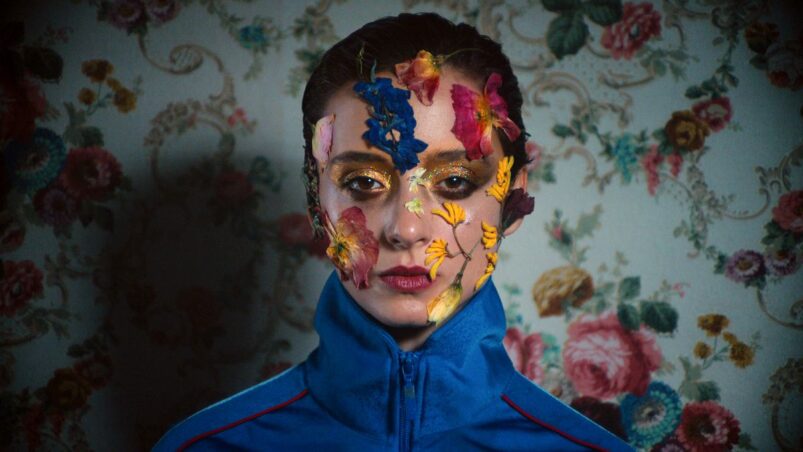Copenhagen Cowboy is a strange sort of career summary for director Nicolas Winding Refn. Since directing Valhalla Rising in 2009, Refn’s distinct style has only become easier to spot and his switch to streaming has certainly helped. His projects are slow (often painfully so), painstakingly framed, lit with aggressive neon hues of blue and red, and contrast that slow pace and visual beauty with chaotic, brutal violence.
It’s a formula that’s served him well, and he’s been able to bring it to a variety of different stories about mythic vikings, criminal underworlds, and the horrors of LA’s high fashion modeling world. But it’s not a style that he’s brought back to his roots in Danish crime films, until now. Refn’s first film, Pusher, was an energetic film that is almost unrecognizable as a Refn project for those only familiar with his work in the last ten years, and Copenhagen Cowboy sees him return to those roots with his new style.
Copenhagen Cowboy brings together Refn’s older, grimier, more free flowing and fluid style with his recent austere approach. It’s a sometimes jarring combination, but makes for an interesting experiment. The show follows Miu (Angela Bundalovic), a young woman who is believed to bring good luck, as she is brought into the house of an Albanian gangster André (Ramadan Huseini) by his superstitious sister so that Miu can help her get pregnant. But the narrative doesn’t really begin until Miu escapes at the end of episode two and finds herself alone in, you guessed it, Copenhagen.
The show initially feels like it may follow a standard three act structure. The first two episodes are centered on André’s home, which also functions as a brothel for trafficked women, but never feel as though they have any narrative momentum. Rather they feel like we are simply waiting for Miu to escape and begin her cowboying around Copenhagen. There are some engaging threads here, like the interaction between André and his daughter when he discovers that she is dating one of his low-level goons, but none of it is compelling on a narrative level.
It’s never good when a film or a series feels as though it goes on too long, but it’s especially a problem when an entire world is painstakingly built and portrayed only for it to feel like something the story needs to move on from as soon as possible. Yes, Copenhagen Cowboy gets better in its third episode, but it’s impossible to consider the success of the entire six-episode show without the failure of these first two episodes.
These opening episodes also introduce issues that, while dampened in the other four, remain problems for the whole of the show. The pacing is actually faster on a moment to moment level than some of Refn’s other material from the last decade, especially his most recent work the extremely (egregiously?) slow Too Old To Die Young, but there’s less tension. Things happening on screen does not equate with energy or narrative momentum and Copenhagen Cowboy is a great example of that, especially in its first two episodes and the waiting-room of André’s brothel. The show admirably seeks to create a sprawling and niche-capturing portrait of the multicultural Copenhagen crime world, but in doing so once again squanders any tension or momentum its story could have.
Yet the show develops into something more exciting as Miu makes her way into the wild west of the Copenhagen underworld and sets out on a mission to avenge her friend and save a woman’s daughter from the gangsters who kidnapped her. We actually get to spend a significant amount of time with the killer Nicklas (Andreas Lykke Jørgensen) and his sex-obsessed family, which is far more attention grabbing, provocative, and unnerving than anything else in the show – really, this character should be the center instead of Miu.
Bundalovic is by no means bad in the role of Miu, but she’s cast in the kind of quiet and dangerous role for which Refn has previously cast people like Ryan Gosling and Mads Mikkelsen – and she simply can’t fill those shoes. It may be an issue of casting an unknown instead of a star, or it may be that Gosling and Mikkelsen simply bring the charisma that made them stars into Refn’s projects, but Bundalovic is not able to carry the weight of these six hours on her physical presence alone.
In theory that’s where Refn’s visuals would come in to save the day, and they certainly put up a hell of a fight. Along with the now requisite blues, reds, and purples, there are some scenes lit with sickly yellow and a surprising (for Refn) amount of daytime exteriors that lack any color stylization. Refn also seems to be exploring new ways to push his style, including several scenes with surreal sound design, impressionistic montages, and an extended horizontal split screen that connects pan-shots moving in opposite directions and lit in starkly different colors.
But sadly, nothing, even the return of some of Refn’s repertory players from his earlier Danish films or the undeniably fascinating inclusion of the supernatural, can save Copenhagen Cowboy from being a disappointment. It’s not a total failure, there are still some interesting ideas here and it certainly looks great, but it fails to come together as a story and isn’t atmospheric enough to work as a mood piece. The show is left in a strange middle ground that’s attempting to be both a thrilling crime story and an atmospheric portrait of a city – but these two parallel tracks end up canceling one another out, leaving us with something that doesn’t work as either.
READ MORE: Brand New Cherry Flavor: Season 1 REVIEW – Stylish Fog
Some of the coverage you find on Cultured Vultures contains affiliate links, which provide us with small commissions based on purchases made from visiting our site. We cover gaming news, movie reviews, wrestling and much more.




